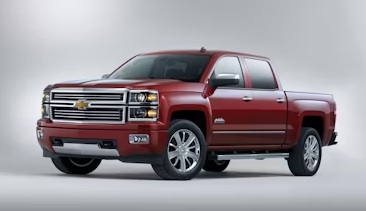

Pick-up, 5 Doors, 4 Seats
367 Hp @ 5500 rpm.
61.5 Hp/l
5967 cm3
364.13 cu. in.
8, V-engine
Rear wheel drive,
6025 mm
237.2 in.
2024 mm
79.69 in.
#N/D
| Brand | Chevrolet |
|---|---|
| Model | Silverado (Pick-up) |
| Version | Silverado II |
| Engine version | 6.0 (367 Hp) Crew Cab Standart 1500 |
| Year production start | 2007 |
| Year production end | 2014 |
| Vehicle type | Pick-up |
| Horsepower RPM | 367 Hp @ 5500 rpm. |
| Overall length mm - inch |
6025 mm237.2 in. |
| Doors | 5 |
| Engine position and orientation | Front, Longitudinal |
|---|---|
| Cylinders | 8 |
| Position of cylinders | V-engine |
| Displacement (liters) |
5967 cm3364.13 cu. in. |
| Eng. horsepower RPM | 367 Hp @ 5500 rpm. |
| Horsepower per litre | 61.5 Hp/l |
| Torque Nm RPM lb-ft RPM |
508 Nm @ 4300 rpm.374.68 lb.-ft. @ 4300 rpm. |
| Fuel delivery system | Multi-point indirect injection |
| Fuel type | Petrol (Gasoline) |
| Valvetrain | 2 |
| Engine aspiration | Naturally aspirated engine |
| Powertrain architecture | Internal Combustion engine |
| Engine location | Front, Longitudinal |
| Drive configuration | Rear wheel drive |
|---|
| Front brakes | Disc |
|---|---|
| Rear brakes | Drum |
| Passengers seats | 4 |
|---|
| Overall length mm - inch |
6025 mm237.2 in. |
|---|---|
| Overall width mm -inch |
2024 mm79.69 in. |
| Overall height mm -inch |
1956 mm77.01 in. |
| Wheelbase mm - inch |
3886 mm152.99 in. |
| Track width front mm - inch |
1730 mm68.11 in. |
| Track width rear mm - inch |
1702 mm67.01 in. |
| Fuel tank liters | gallons |
98 l25.89 US gal | 21.56 UK gal |
|---|
8 CYLINDER V-Engine
https://www.thecarspec.net/components/engine/8-cylinders-v